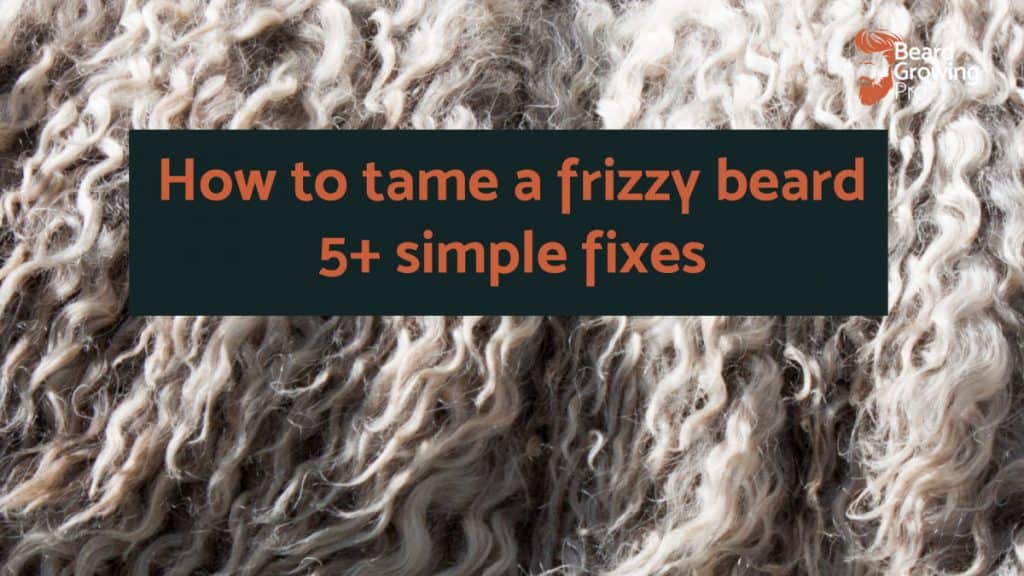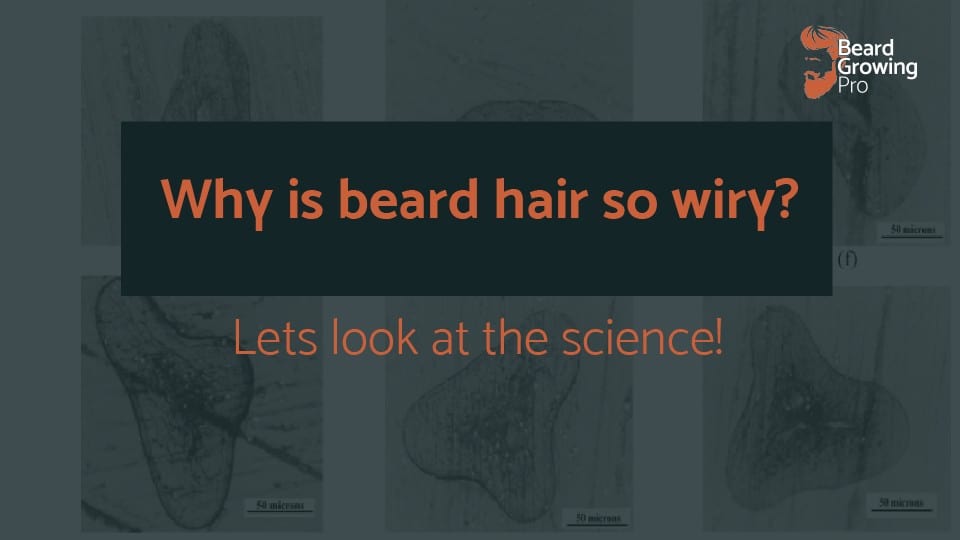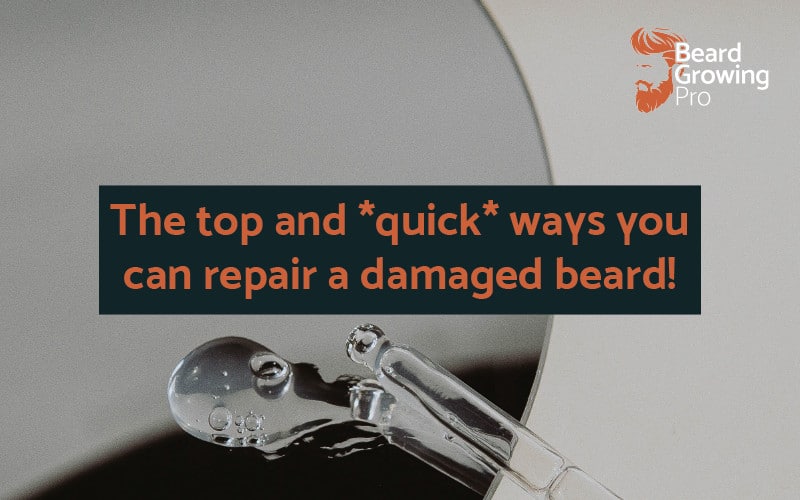Damaged beard hair is easy to identify simply by looking at the condition of the beard. You may have seen people out in the public who have beard’s that look dull, dry, frizzy, and thin. Luckily there are plenty of things you can do to prevent your beard from looking damaged, and some of the symptoms are an early warning sign for much more serious issues.
A damaged beard looks dull and lifeless. It is likely to contain many split ends, increasing the frizzy appearance. The dry texture means the beard hair looks very wiry and will be very coarse when touched.
In this article, we will go over what damaged beard hair looks like and the common causes and all of the things that you can do to return your beard to its best.
There are certain levels of damage that you can easily classify when looking at your beard. These can be summarised in the stages below:
- cuticle damage – your beard is looking dull and lifeless at this stage. There is no change to the beard hair length and is the early warning signs of much worse things to come.
- Hair shaft irregularities – knotting and hair shaft defects are common at this stage. These areas are where the cuticle has been fully compromised, and it may take up to 3 months of treatment to return to its former glory.
- Full hair breakage – at this stage of the damage, your beard will be looking then and lifeless. The hair will be see-through at the ends and very brittle when touched. The beard has lost the ability to create defined lines through trimming due to varying lengths in the beard.
Catching the beard damage as soon as possible and reacting early, you’ll be able to stop your beard hair from becoming damaged and breaking off.
Article Contents
1. Dull
Dullness in a beard is one of the easiest things to detect. Healthy beard hair has a shine and lustrous look. Dull hair is due to the cuticle’s (outside hair cells) not laying flat and scattering the light as it reflects off the beard’s surface.
Beard hair will never look as shiny as head hair, but it should be smooth to the touch – this is one of the best ways to determine whether or not the hair is asking for your help.
There are plenty of reasons why a hair may look dull, including over-washing your beard, using the wrong shampoo, having low sebum production on your face and much more.
Early dulling of your beard should indicate that you need to change your beard maintenance routine. Changing your routine could respond to new seasons or new environmental conditions.
Continually air on the side of caution and add a good amount of hydrating products to your daily beard routine to tackle the dullness which can arise through no fault of your own.
2. Split ends
Split ends are very common in damaged beards. Split ends are the fraying of the hair shaft and are likely to be formed if your beard hair is particularly dry. The beard hairs will look like unravelled rope at the ends.
Split ends are a secondary effect of dryness resulting from heat tools, bad shampooing, and environmental conditions.
The split ends can cause further damage further up the shaft of the beard hair, and the best way to ensure this doesn’t happen is by cutting them off. You only need to cut off a couple of millimetres above the height of the fraying to protect your beard from further damage.
Every bearded person will have to deal with beard split ends at some point. I often find my beard split ends when my beard hair’s fallout. I notice the end is frayed, indicating that I need to jump on top of the issue immediately.
I have waited before treating beard split ends in the past, and the problem worsened exponentially. Acting sooner will solve a whole lot of issues later down the line.
3. Frizzy
Damaged beard hairs often look very frizzy. It can be very hard to determine the underlying issue of the frizziness. Taming a frizzy beard means tackling dryness and trimming up your beard hair to remove split ends.
Also, a particularly wiry and curly beard can sometimes look frizzy because it has recently not been trimmed up into a defined shape.
If your beard looks dense when you look at the bulk of the beard but then is fluffy and frizzy on the very ends and lines of the beard, you should consider tackling this problem head-on.
Solving frizziness relies on tackling the root causes of the issue. Protecting your beard from external and environmental damaging factors is the first way to ensure that frizziness isn’t introduced to your beard.
Protecting your beard from UV rays with a UV protector is imperative if you work outside. Covering up your beard with a beard wrapped during particularly damaging activities such as DIY and sunbathing is one way you can stop your beard from becoming damaged from the inside out.
4. Wiry
A damaged beard hair is a much wider area than healthy hair. Beard hair is wiry because damaged beard hairs are rougher and more likely to become intertwined. Beard hairs rely on smooth outside cuticle cells to flow over each other easily.
Tangled beard hairs are easy to spot, and they make themselves clear when you are combing and brushing your hair. The dryness of your beard will dictate how wiry it feels, and make sure that you deep condition and nourish your beard hair throughout its life on your face to stop it from becoming dull and tangled.
Your genetics dictates the wiry nature of your beard, and your beard hair texture can go from thin and straight to coiled and curly.
- Straight hair – people of Asian heritage will often have straighter and fairer beard hair than Caucasian or African descent.
- Wavy hair – It is common for people of Caucasian descent to have wavy beards with some curliness but not a tightly curled beard.
- Coiled and curly hair – Typically, people of African descent will have much curly and coiled hair than other nationalities.
If you notice any significant difference in your beard’s wiry nature, you need to consider an intervention soon as possible.
5. Dry
A damaged beard hair is typically very dry. The dryness can be seen, but it is better to be felt.
Does your beard flow nicely and with minimal resistance when you stroke it? Does it feel relatively smooth when you pick out a small tuft of hair and run it through the pads of your fingers?
A dry beard is very easy to distinguish when touched.
I am constantly touching my beard, and I recommend doing the same. Lightly running your fingers and hands over the top of your beard will allow you to identify any changes which occur.
I often find that my beard is particularly dry in the Australian heat. I need to make sure that some times are full of moisturising and deep conditioning treatments that allow my beard to recover from the harsh and dry environment I find in South Australia.
Dryness can also occur in cold climates due to the wind and low humidity conditions.
6. Thin
Another easy to identify issue with a damaged beard is its density. A thin beard is easy to see through, and I go through all of the reasons why your beard looks so thin in my YouTube video below.
The hair density is severely impacted once your beard hair becomes damaged. The hairs break off, and the overall thickness and bulk of the hair become much thinner.
A thinning beard is a much later indicator of a severely damaged beard. If you have noticed a significant thinning out of the beard hair, you have to tackle fundamental issues with your beard, such as ensuring that you eat the appropriate nutrients to support your growth and protect the beard hair from the inside.
Beard hairs that break easily and are not replaced once they fall out to indicate a much deeper issue than beard hair. Suppose you notice a lot of hair fall it’s time to seriously consider changing your daily beard routine and improving your overall health by exercising and changing your diet.
7. Irritated skin
Damaged beard hair can also stem from irritated and inflamed skin under the beard.
A poor hygiene routine or a reaction to any of your beard products may cause damage to the root of the beard hair, which may starve it of essential nutrients for growth.
Irritated skin can become an issue for beard growth if the irritation severely inflames the hair follicle and root.
Using hydrating skin products formulated for rapid absorption into the deep layers of the skin and steering clear of any irritants is the fastest way to resolve any skin irritation issues.
I recommend completely stopping using beard products and slowly reintroducing them into your routine if you suspect that one of your beard products is causing an allergic reaction.
What can damage your beard
your beard is constantly with you, which means it is exposed to all of the same pollutants and environmental conditions you are. The beard on the front of your face can easily become damaged from UV rays, heat tools, and diligent shampooing with the wrong products.
To protect your beard, I recommend ensuring you stay away from extreme UV light sources and double-check your shampoos and heat tools are completely suitable for protecting your growth.
Sun
One of the most destructive elements to your beard is the sun. UV radiation can create free radicals, which can harm the DNA of beard cells.
In your beard, there are free radicals, which are highly energetic organisms. They are created naturally by metabolic processes and rely on antioxidants to counteract their effects.
To minimise the effects of the sun and UV rays on your beard, make sure you consume a varied diet rich in antioxidants and protect your beard when out and about in the sun.
Shampoos
Overwashing your beard can easily harm it by removing the beard’s natural oils. Make sure you’re using a beard shampoo that’s been specifically made for beards. When you use a head wash on your beard, you’re removing too many natural oils.
The composition of a head shampoo will reflect that your head is oilier than your face.
Heat tools
The practice of hair straightening might alter the physical appearance of the beard. It accomplishes this by disrupting the hair’s structural integrity by breaking down some of the links between the keratin filaments. The process is done frequently, and many beard growers rely too heavily on heat treatment to keep their beards under control.
Over the years of growing my beard, I’ve realised that there’s no reason you shouldn’t straighten it because it’s a very helpful instrument. Check out my other article, Should You Straighten Your Beard? for further information on whether or not you should straighten your beard. Click here for the complete guide.
How to repair a damaged beard
There are many ways that you can repair a damaged beard in all of the cases prevention is much better than a cure.
Prevention
Preventing your beard from becoming damaged is as easy as working out a suitable daily routine. Looking after your beard is a marathon and not a sprint and a manageable (but imperfect) daily routine performed regularly is better than jumping on issues when they arise.
Daily maintenance
Establishing a regular routine is the key to growing a great beard. Beards appear better when they’re groomed every day – even if it’s just a little. Most individuals prefer to conduct one big grooming regimen once a week or twice a fortnight, but this rarely results in the best-looking beard.
My daily routine includes:
- showering and shampooing my hair – I do this every 2 to 3 days or when I have done a particularly dirty or stinky activity.
- Trimming up the cheek lines and neckline – while I’m in the shower, I will also use a single blade safety razor to trim up the cheek line and the neckline of my beard. This step will allow me to keep the line sharp, one of the best ways to keep your beard impressive and looking dapper.
- Towel drying my beard – as soon as I jump out of the shower, I gently dab my beard dry. It does not eliminate all the moisture, and I have to be very careful as wet beard hair is the easiest to damage. But I remove most of the moisture with a towel.
- Blow drying my beard – I use quite a systematic hair drying routine on my beard. Firstly, I will use medium to high heat with downward coming to it rid of the majority of the moisture. Then I will use a cold setting on my hairdryer with downwards combing or brushing to style the beard.
- I will use a beard oil application most days to add a little bit of nourishment and shine back into my beard after shampooing. Please do not overdo it as the beard does not absorb a lot of the oil – less is more.
- Application of beard balm, butter, or wax – if there is a special occasion or I need my beard to look particularly good for any reason, I will follow up the application of beard oil with another product. The other product will probably contain a small amount of beeswax to hold the style in place.
This routine may seem like a lot, but it only takes me between five and 10 minutes every morning as now I have made it part of my morning without really thinking about it.
Emergency treatments
Emergency treatments of your beard should be saved for emergencies.
Deep hydration treatments and leaving stuff in your beard overnight should be performed about once every couple of months rather than as a fix for an issue you have just got to your wits and about.
If you want to know more about the top ways to repair a damaged beard check out my article below.

![What does damaged beard hair look like? [7 symptoms] - Beard Growing Pro](https://beardgrowingpro.com/wp-content/uploads/2021/12/What-does-damaged-beard-hair-look-like.jpg)





